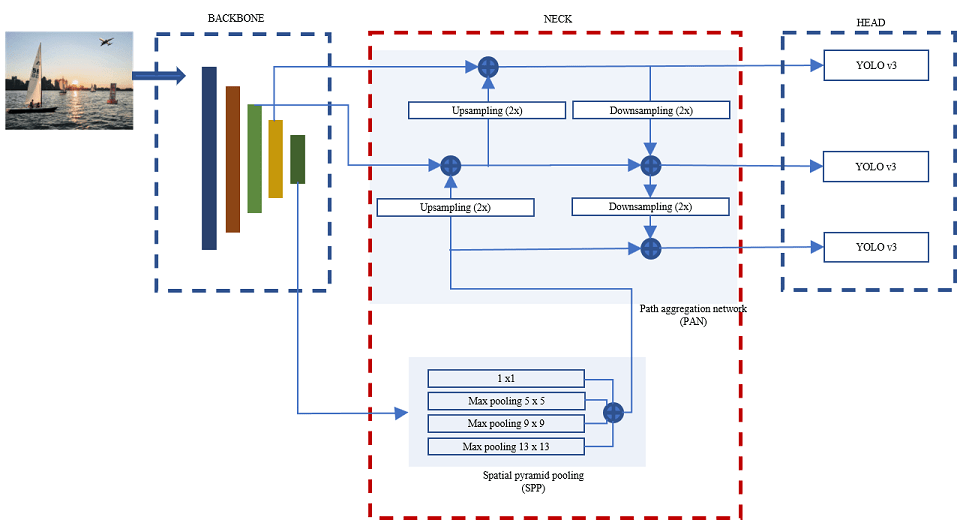目标检测算法在自动驾驶中的应用:YOLO训练Caltech行人数据集实战指南
发布时间: 2024-08-16 10:30:13 阅读量: 27 订阅数: 28 


# 1. 目标检测算法概述
目标检测算法是一种计算机视觉技术,用于识别和定位图像或视频中的对象。目标检测算法通常分为两类:两阶段算法和单阶段算法。两阶段算法首先生成候选区域,然后对这些区域进行分类。单阶段算法直接预测目标边界框和类别,速度更快。
YOLO(You Only Look Once)算法是一种单阶段目标检测算法,因其速度快和准确性高而闻名。YOLO算法将图像划分为网格,并为每个网格单元预测目标边界框和类别。YOLO算法的最新版本YOLOv5在COCO数据集上的mAP(平均精度)达到56.8%,速度为每秒60帧。
# 2. YOLO目标检测算法原理
### 2.1 YOLOv1算法架构和实现
YOLOv1算法是YOLO系列目标检测算法的开山之作,它将目标检测任务转化为一个回归问题,通过一次卷积神经网络的前向传播,直接输出目标的边界框和类别概率。
**算法架构:**
YOLOv1算法架构主要分为以下几个部分:
- **卷积层:**用于提取图像特征,由多个卷积层和池化层组成。
- **全连接层:**用于预测边界框和类别概率,包含两个全连接层。
- **损失函数:**用于衡量预测值与真实值之间的差异,由边界框损失和分类损失组成。
**实现流程:**
YOLOv1算法的实现流程如下:
1. 将输入图像缩放到固定大小(例如448x448)。
2. 将图像输入卷积神经网络,提取特征。
3. 将提取的特征输入全连接层,预测边界框和类别概率。
4. 使用损失函数计算预测值与真实值之间的差异。
5. 反向传播更新网络权重。
**代码示例:**
```python
import tensorflow as tf
# 定义卷积神经网络
model = tf.keras.Sequential([
tf.keras.layers.Conv2D(32, (3, 3), activation='relu'),
tf.keras.layers.MaxPooling2D((2, 2)),
tf.keras.layers.Conv2D(64, (3, 3), activation='relu'),
tf.keras.layers.MaxPooling2D((2, 2)),
tf.keras.layers.Flatten(),
tf.keras.layers.Dense(128, activation='relu'),
tf.keras.layers.Dense(7, activation='softmax')
])
# 定义损失函数
loss_fn = tf.keras.losses.CategoricalCrossentropy()
# 训练模型
model.compile(optimizer='adam', loss=loss_fn)
model.fit(x_train, y_train, epochs=10)
```
**逻辑分析:**
该代码示例实现了YOLOv1算法的卷积神经网络部分。它首先定义了一个卷积神经网络,然后定义了一个损失函数,最后编译并训练模型。
### 2.2 YOLOv2算法改进和优化
YOLOv2算法在YOLOv1的基础上进行了多项改进和优化,包括:
- **Batch Normalization:**加入Batch Normalization层,提高模型稳定性和训练速度。
- **Anchor Box:**引入Anchor Box机制,减少网络预测的边界框数量,提高检测精度。
- **Dimension Clusters:**使用k-means聚类算法对训练集中的边界框进行聚类,生成一组Anchor Box,进一步提高检测精度。
**代码示例:**
```python
import tensorflow as tf
# 定义卷积神经网络
model = tf.keras.Sequential([
tf.keras.layers.Conv2D(32, (3, 3), activation='relu'),
tf.keras.layers.MaxPooling2D((2, 2)),
tf.keras.layers.BatchNormalization(),
tf.keras.layers.Conv2D(64, (3, 3), activation='relu'),
tf.keras.layers.MaxPooling2D((2, 2)),
tf.keras.layers.BatchNormalization(),
tf.keras.layers.Flatten(),
tf.keras.layers.Dense(128, activation='relu'),
tf.keras.layers.Dense(7, activation='softmax')
])
# 定义损失函数
loss_fn = tf.keras.losses.CategoricalCrossentropy()
# 训练模型
model.compile(optimizer='adam', loss=loss_fn)
model.fit(x_train, y_train, epochs=10)
```
**逻辑分析:**
该代码示例在YOLOv1算法的基础上加入了Batch Normalization层,提高了模型的稳定性和训练速度。
### 2.3 YOLOv3算法的创新与突破
YOLOv3算法是YOLO系列目标检测算法的集大成之作,它在YOLOv2的基础上进行了多项创新和突破,包括:
- **Darknet-53:**采用Darknet-53作为卷积神经网络的骨干网络,提取更深层次的特征。
- **Multi-Scale Detection:**在不同尺度的特征图上进行目标检测,提高检测精度和鲁棒性。
- **Loss Function Improvement:**改进损失函数,平衡边界框损失和分类损失,提高模型性能。
**代码示例:**
```python
import tensorflow as tf
# 定义卷积神经网络
model = tf.keras.Sequential([
tf.keras.layers.Conv2D(32, (3, 3), activation='relu'),
tf.keras.layers.MaxPooling2D((2, 2)),
tf.keras.layers.BatchNormalization(),
tf.keras.layers.Conv2D(64, (3, 3), activation='relu'),
tf.keras.layers.MaxPooling2D((2, 2)),
tf.keras.layers.B
```
0
0





